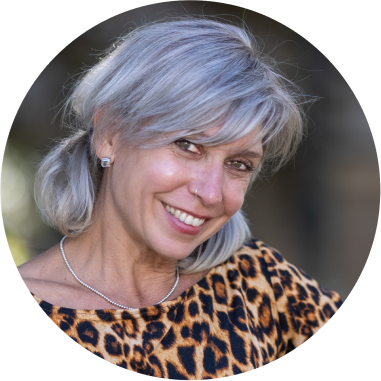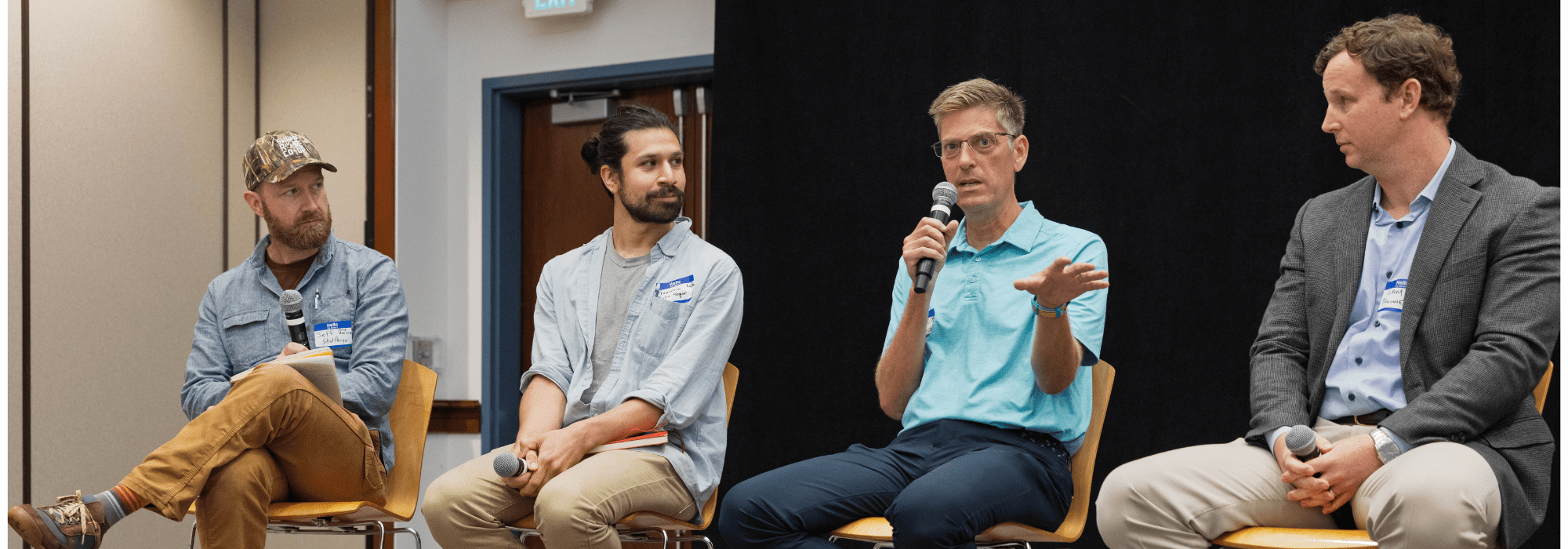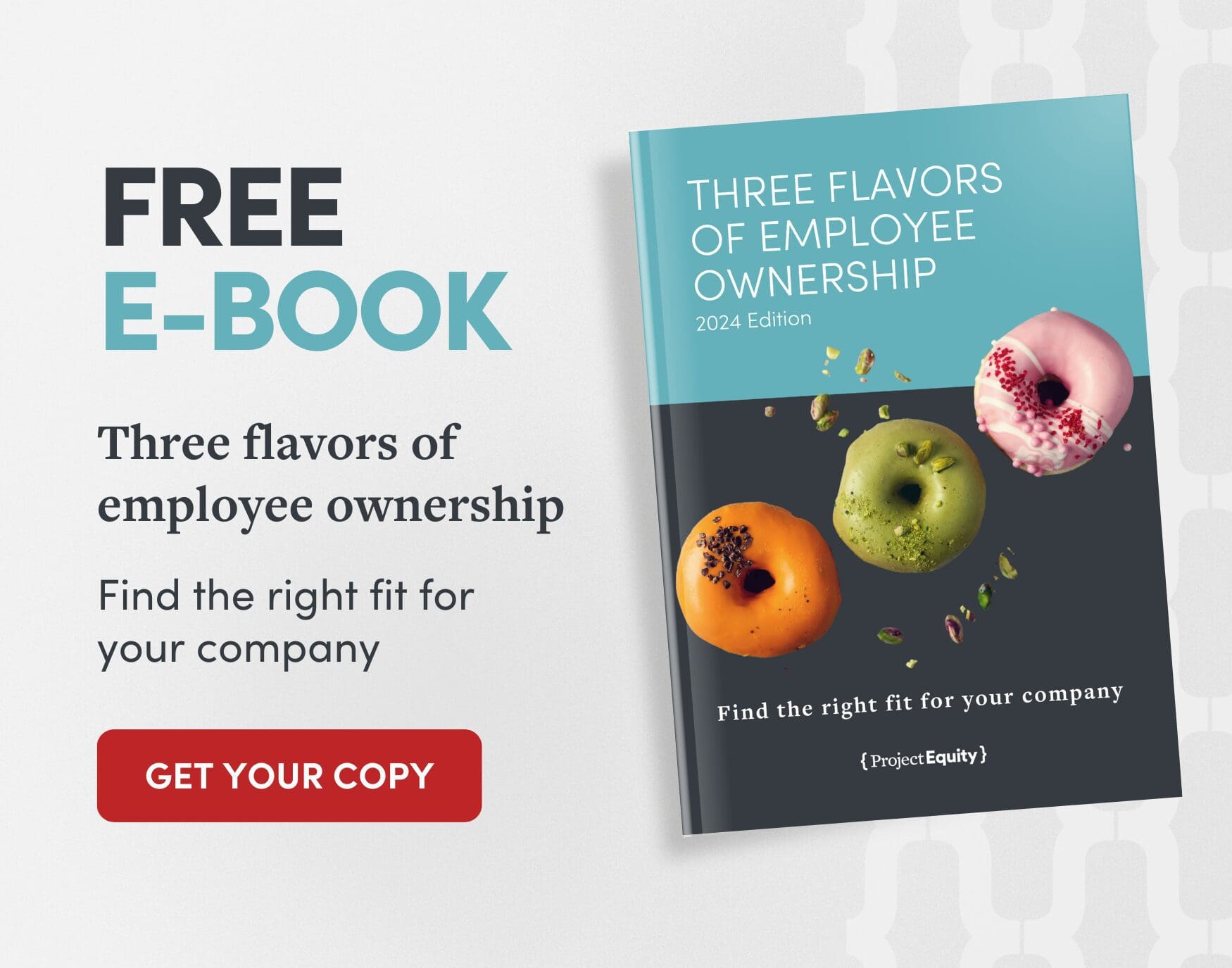Inside an ESOP: how employee ownership transforms a business
- Franzi Charen
At our latest convening in Montgomery County, Maryland, we were honored to invite Sam Brownell of Stratus Business Advisors to moderate a panel of people deeply involved in three employee-owned businesses in the region. Craig Smith, CEO of the Cool Hardware Company, a group of employee-owned Ace Hardware stores in the Washington, D.C. region, joined the discussion.
What follows is a synopsis of his contribution edited for clarity and brevity.
Craig Smith: Hey everybody, I’m Craig Smith, CEO of the Cool Hardware Company, also known as a few Cool Hardware Stores. We have 13 locally owned and employee-owned Ace Hardware stores throughout the region, D.C., Baltimore, Montgomery County, and Northern Virginia. The closest one to where you’re sitting right now probably is Silver Springs Ace Hardware. We’re also opening a new store for any of you living locally, in Rockville, and, by the end of this year, one in Wintergreen Plaza. So we’re 14 stores at the end of this year. And I came with the company, I’ve been in the retail hardware business for about 25 years and with Ace Hardware stores for about a dozen years.
Craig: I opened my [first Ace Hardware] store in Fairfax, Virginia in 2011, I opened another one in 2016, in Arlington, Virginia, and then in 2023, my predecessor, Gina Schaefer, our founder, tapped myself to be CEO of the company I’m at right now, and bought my store as well, as she transitioned the business [to an ESOP]. And that’s how I came to be here today.
Craig: So I know we’re talking about coops, and the cool thing about our transition, and the thought of even becoming an ESOP, is we are part of the Ace Hardware Corporation, which is a cooperative. And I like to talk about Ace Hardware being a coop, because a lot of people don’t know. They think we’re just a Target, Home Depot, Subway, whatever the case may be, in terms of either a corporate [chain] store or franchise. We are neither.
Author’s note: Ace Hardware is a retailer-owned purchasing cooperative. They pool the collective buying power of thousands of independent Ace stores to secure better prices from suppliers for merchandise and services. This model allows individual local store owners to leverage economies of scale to compete with larger chains, receive profits back as dividends, maintain independent ownership and flexibility, and gain access to resources like distribution centers and marketing programs, ultimately strengthening the entire coop.
Craig: There’s about 5,500 baby stores right now. Most of them are individually owned and operated. And those are the folks who own Ace Hardware Corporation. It is not publicly traded. It’s private. And the cool thing about a coop, you don’t have to give a percentage of your sales back to the parent company.
Craig: We serve our communities with a lot of flexibility. Being a coop, that’s one of the things I love. So that kind of sets the stage for, you know, what do you do when you want to transition out?
Craig: So I’ll get to that a little bit. My predecessor, Gina Schaefer, our company’s founder, wanted to transition out of the business. She’s now a professional speaker, author, etc.; some of you may be familiar with her. She does a wonderful job with that. [She and her husband, Mark] did not have children. They did not want to sell to private equity. And they thought, being in the space of the coop model, they wanted to become an ESOP.
Craig: So what Mark and Gina did, Mark is currently our CFO, and this predates me by a couple of years in the company. But I’ll try to get the story correct for everybody here. They sold 30% of the company to an ESOP trust. They borrowed the money, made the trust. Funded the trust enough so it could buy 30% of the company, and then that 30% is what employee-owners own, today, in the core of our company.
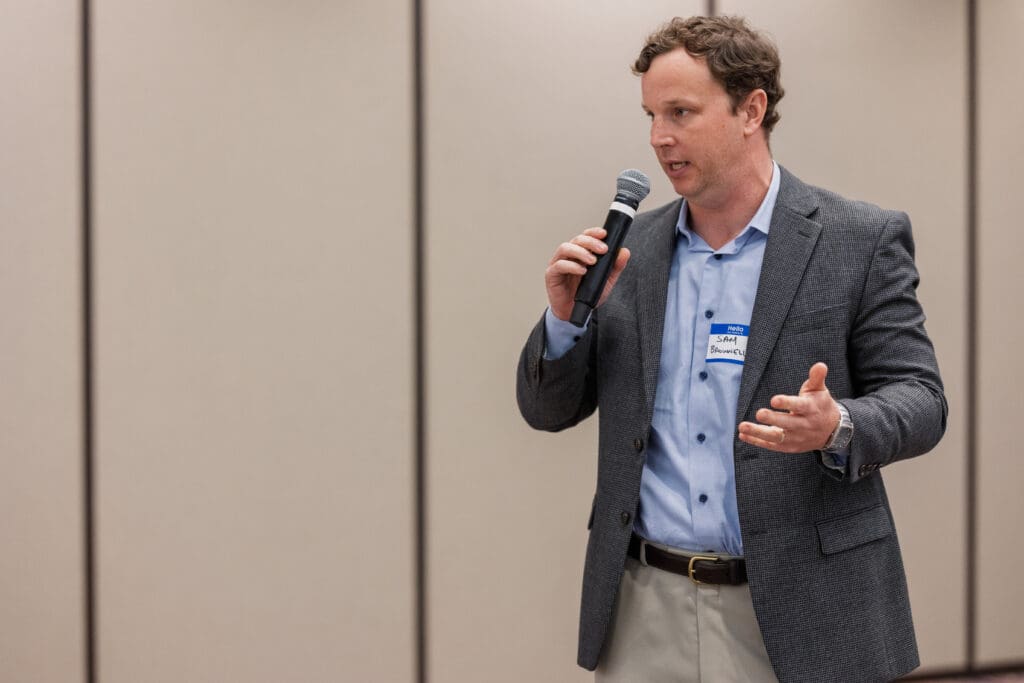
Sam Brownell: Yeah. And that actually brings up a really good point. One of the interesting things, particularly about these two models, coop and ESOP, is that if you have a business owner who is very tax=conscious; there is what’s called section 1042 exchange. It’s very similar to what we do in real estate. You have to sell at least 30% of the business. But at that point, without getting into too many details, you can defer capital gains taxes on the sale of that 30 or more percent of the business. And that can be a very powerful motivator for some people to consider.
Sam: An ESOP is a retirement plan; it’s under ERISA [Employee Retirement Income Security Act]. And so it is very technical and you have to be very careful when you set it up. It’s also something that doesn’t work if you have [only] ten employees. You have to have a broad enough employee base so you can have a level of W-2 wages to be able to pay back the loan that he was talking about, because it’s a trust that ends up owning the shares.
Sam: And so Craig was telling us as we were talking over breakfast about the way that it works when an employee comes in and then what happens when they go out. So, how do employees end up becoming part of the ESOP?
Craig: Sure. So, that’s a good way to put it. Why would someone want to be a part of it? Essentially it’s a retirement plan, but it’s free. If you come to work for the Cool Hardware Company and you have 1,000 hours put in and you work for us for a year, which is averages like 22 hours a week, you qualify for being in our ESOP, so we give you shares in the company for free. You do not pay for them. It’s not a match like a 401(k), but it’s treated and held in a trust, kind of like a 401(k) would be. So that’s how you become a member of the ESOP.
Sam: And then annually, based on your salary and if you continue to work that thousand hours, you’re issued additional stock and there’s an annual vesting schedule, you start at 20%, 40%, 60%, 80% and 100%. So it’s roughly like a six-year plan to be 100% vested. But the cool thing is, you’ve gotten all of this and you haven’t paid a penny for it. It’s all been given to you, and we want to give it to you, if you stay with us and you have tenure. It’s a way to reward that.
Craig: There are a ton of rules and regulations. I’m not going to hide that. We have a 40-page plan, which I’ve read about 52 times, and I still am not sure if I know every nook and cranny in it. I’m asked about it a lot. We have an ESOP trustee that helped found this ESOP, initially. We have an annual audit that happens that is so thorough, and they might even check what’s in my pocket.
Craig: And it’s actually ongoing right now because we just issued stocks, and we completed our audit for every financial aspect of the company except the stock issuance. Now the issuance has happened. So they’re auditing that; actually just got an email about that. Now that is a lot of work. But what it does is keep us operating efficiently. From top to bottom, it makes sure we’re not leaving any stone unturned in terms of how we operate our business. We have a third party that monitors all of that. And we have to answer to them. And they want to know why we did this and why we did that. And where is this chair that was supposed to be there? And so for $50, it says, you have it and we can’t find it. You know, little things like that. We go over everything.
Craig: So in the end, it makes you a great operator. You need to be a very good operator before you try something like this. And I’m sure many of you are, but you turn into a great one, when you’re audited every year.
Sam: Yeah. So, that’s something to understand. What’s great about the ESOP model in particular, is that your employees now have direct ownership in the value of the company. And that’s motivating right there. If I, if I came in at $10 a share and we can improve margins by half a percent, right? Which, in the hardware space, is a lot. That then means, maybe my shares are worth $15 now. And that can be a really powerful way to create wealth.
Craig: One of the nice things about these models is that you don’t have to jump in 100%. You can do a partial [transition to an ESOP].
Sam: Do you guys have a Board? And how do the employees engage, if they do, with the actual oversight and strategic direction of the company?
Craig: Good question. So, I first learned about employee ownership when I was approached to join this company. I thought employee ownership meant getting in a room like this and everybody making every decision all day, like, raise your hand, put a card in a box. But the truth is, in our company we have probably a fairly traditional structure with myself [as CEO], the CFO, a Director of Operations, we have a buying team, we have H.R. We have all of that. We also have significant leadership in each one of our stores with managers, assistant managers, leads, etc. So it does work in a fairly traditional model.
Craig: What I’ll say is, you know, we’re a very open employer. We always have been since the founding of this company. We’re also a second chance employer. We welcome people of all histories and backgrounds to our company and encourage that.
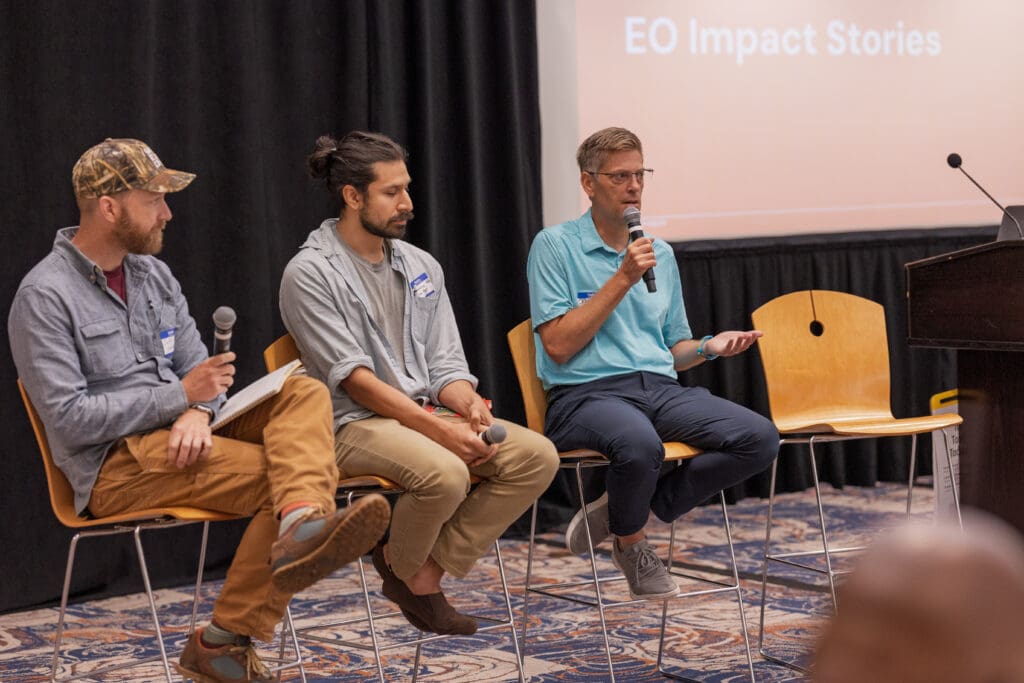
Craig: So we [also] have an open-door policy. I know a lot of people say that, but we definitely solicit comments. When we make a big decision, we want to explain it. I always want to explain the why and not just say, this is what we’re doing.
Craig: But people do have that sense of entrepreneurship that I had when I opened my store in 2011. I was like, I’m in it. I’m thinking about it 24 hours a day and putting all my money on the line on this, you know. [It’s] not quite the same, but I want people to have that owner operator mindset.
Craig: And I think I heard it was entrepreneurship 2.0 or, you know, that I thought that was a good term. But people, when they have their stock, they do think twice about the impact of what they’re doing and how it does affect the bottom line, because that affects their stock price and what they’ll get when we issue stock annually.
Audience member: I have a question about three things. So growth, can the company grow and how are those decisions made? What kind of training is offered to get people into the company, if you don’t have the skills that are needed? And the other is a living wage.
Craig: So we operate in different jurisdictions: D.C., Maryland and Virginia. And they all have different minimum wage requirements. We made the decision a long time ago to reflect the highest minimum wage of any of those three jurisdictions. D.C. just had a raise to $17.95 an hour, for minimum hourly pay. So that’s what we pay in Northern Virginia, Baltimore, Montgomery County and D.C. as well.
Craig: Many of our team members do live near where they work. Not always. It’s definitely not a hard and fast rule, but that’s where we encourage people to go. We always strive to pay well enough where someone can do that. Also commutes are important. Commuting is very expensive, time-consuming, stressful, all of that. That really does play into it. It’s kind of like a hidden wage, it’s extremely important. We want people to put money back in our communities, too. This is why we have this rule in our company that we pay whatever the highest minimum is.
Craig: And, you know, the number one thing people say in our employee engagement surveys every year is what do they want more of? Training. So training is extremely important. And we do have a lot of in-house training resources. But really when you come on, we’re just looking for people who are friendly, who are great customer service folks. And basically we consider we can teach you the rest, although, you know, if you have some skills, that’s great.
Craig: And growth. Yeah. I think judicious growth has been my formula. You know, I came on in 2023, we’re going to be opening our first new store this year. So I’ve taken my time a little bit to do that. We have another store coming on in 2026 in Union Market in D.C. So we’ve got two new stores coming on. But it’s got to be done very carefully, judiciously. Not only do we have a sizable company and a lot of employees, which are very important to us. But, you know, 52% of our active employees, who are not seasonal, are employee-owners and shareholders. So I have a fiduciary duty to them, as well as all of our team members. And, we certainly consider that when we make big decisions on growth.
Craig: I was saying before, I’m a big proponent of the employee-owner-operator mindset, which I equate to an employee-owner mindset. Meaning, this is mine; I’m influencing how this company is going to do by my actions. And it’s not just, you know, you do get a biweekly paycheck, but it’s more than that because there’s another check or there are another set of funds waiting for you down the road based on what actions you take.
Craig: I will say it’s not everything. Employee ownership does not mean you’re going to get, you know, hundreds of people through the door tomorrow, wanting to be with you. But it does influence retention greatly. It helps our retention. We have a fairly low turnover rate, especially in the retail industry, which is known for a very high turnover rate.
Craig: And we talk about it every day. Employee ownership. And it’s something to be proud of, really, for people in an hourly retail job, which is unfortunately, you know, not a profession that’s very respected in our country by a lot of people, which I completely disagree with. And an ownership stake is always a good thing, especially in a position like that.
Sam: Yeah. And I guess I would add, we do a lot of work in the hardware space, the biggest problem you hear is recruiting and retention. And this solves that problem. Certainly, you’re never going to solve the problem 100%. But what Craig is talking about is something that is an easy sell to these people.
Sam: Because on one side, if you want to run a profitable business, you have to have the employees. On the other side, for an employee who wants to build wealth, it’s really hard to jump around from job to job every 6 to 12 months.
Audience member: I’m trying to understand how the number of shares are determined? And, how does it grow with the company as the company grows? Is there like some standard formula there, or maybe just how did you do that in terms of determining the number of shares?
Craig: Initially that was determined by our ESOP trustee and a bank. You can envision a wall between our company, financially there’s like 30% owned by the team and 70%, at this moment, is owned by individuals. And that 30% was shares calculated by our ESOP trustee, and they have a certain value.
Craig: And that value can fluctuate up or down. The amount of shares you’re awarded is based on your compensation as well, it’s not only tenure and vesting schedule. Which means like how much of that money is actually yours. It goes up to 100%, of course it starts at 20%. But you can be awarded more shares based on your compensation. So higher levels of the company can be awarded more stock.
Sam: So what happens with an ESOP, when the transaction actually happens, whatever the number of shares are in the transaction are put in an escrow account. Then those shares are released, over time, to the employees. As they vest, they’re allowed to get those shares. And so you have to be very careful when you design an ESOP so that you don’t end up running out of shares. Right? That’s the big problem you can run into. It’s part of the reasons why ESOPs are by far the most expensive [employee ownership] transition options.
Sam: You may pay between $250,000 and $500,000 to set it up, and then it’s $20,000 to $40,000 a year at least. It’s typically in that range, because the shares have to be valued every year. Right. Because it is a retirement plan. People need to know what they own. It’s an expensive way to go, but it’s also got its benefits.
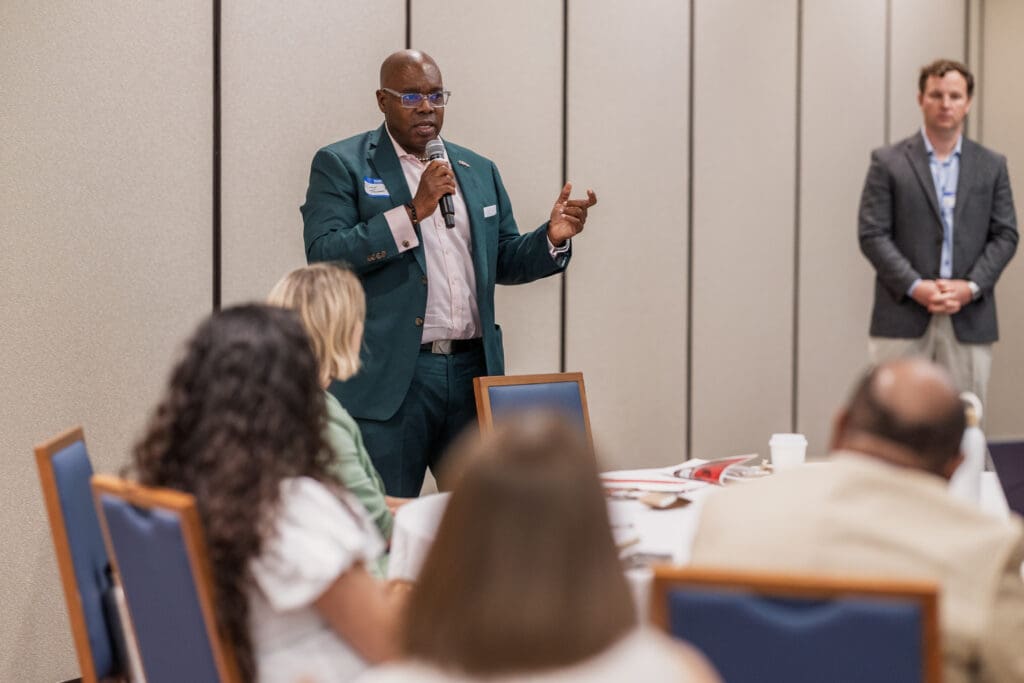
Evan Edwards (CEO, Project Equity): But one of one of the important offsets is that whatever percentage of the business is owned by the ESOP [as an S-Corporation], that same percentage is no longer subject to federal income tax. So the potential offset can make up the difference.
Craig: And we did change from individual LLC to an S-Corp at the start of our ESOP program.
Sam: Yeah. And the best way to do an ESOP is to start as a C-Corporation. You sell to the ESOP, you use the 1042 exchange, you defer capital gains, and the day you become an ESOP, you change the filings to an S-Corp.
Sam: But that’s not for everybody.
Sam: Typically, when we run these types of calculations, we run it in all the different scenarios. Are you going to be a C and go to an S? Are you going to be a C and stay a C, or are you going to be an S the whole way?
Sam: But to get to your question, it’s a finite amount of shares. Right. There’s not an unlimited amount. And that can get ESOPs in trouble. Because if they’re not designed well, they run out of shares and then you’re in trouble.
Sam: So Craig, do you know who you all used for financing?
Craig: National Cooperative Bank. And they actually work with a lot of hardware stores in general. And they do work with ESOPs.
Sam: They’re in Arlington, VA, right next to Reagan National Airport. But yeah, National Cooperative Bank is a good one. Evan, do you want to talk a little bit about some of the funding that you all have at Project Equity?
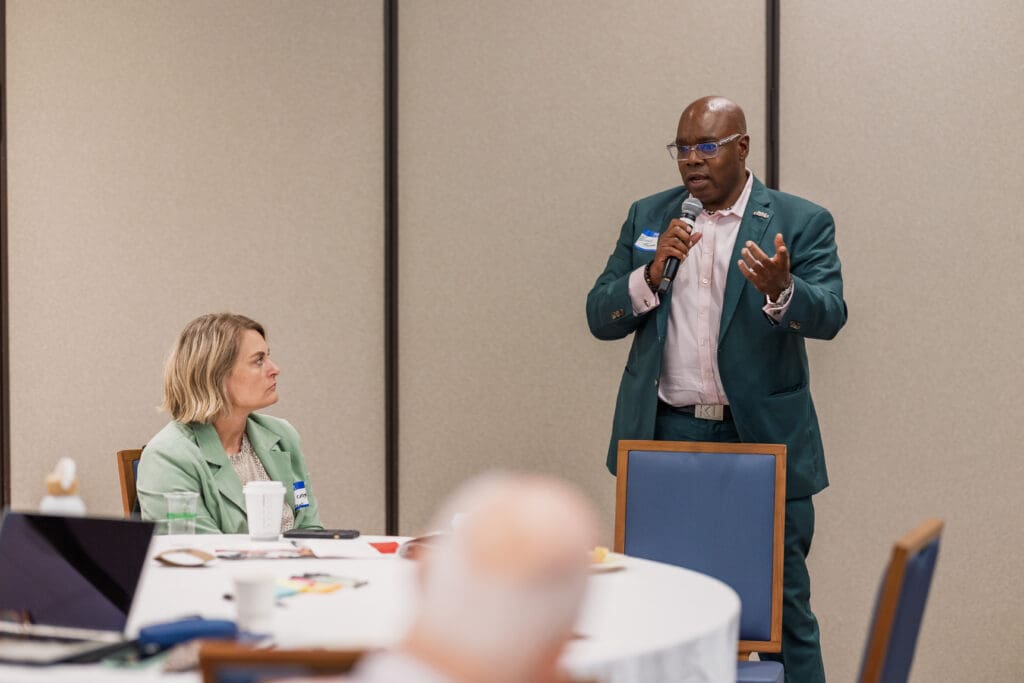
Evan: So traditionally, there’s been a dearth of financing facilities for these transactions, less so with ESOPs, more with coops and Employee Ownership Trusts. And that’s essentially because they’re leveraged buyouts and your typical lender requires a personal guarantee.
Evan: And, we’re working generally with workforces [where] there’s not going to be an individual owner for that particular commitment. And so traditionally, there have not been a lot of lenders, capital providers to support these transactions. Sam mentioned the National Cooperative Bank. Project Equity has long partnered with Shared Capital Cooperative, which is based in Minneapolis. There are a handful of others.
Evan: What we found at Project Equity, because there was not enough capital to keep up with the deals that we were doing, we had to raise a capital fund. So we partnered with another organization and were beneficiaries of an initiative called the Quality Jobs Fund.
Evan: And the Quality Jobs Fund invested $5 million in a fund for us in partnership with Shared Capital Cooperative. That allowed us to be able to do transitions, specifically to coops, and not have to obligate workers to any sort of personal guarantee. We were limited in terms of the geography that we could deploy that capital.
Evan: It was capital that came from the Federal Home Loan Bank of San Francisco and was funneled through the New World Foundation to the Quality Jobs Fund. Once we proved that we could deploy the capital, all of our loans were serviced successfully. We had no default. And that’s one thing that’s really important to remember. Employee-owned companies are much more successful in terms of their fulfillment of their capital obligations than your typical business. Now, in our case, we’re really buttoned up in our due diligence because we know if we have a bunch of businesses that fail then everybody thinks, oh, employee ownership doesn’t work, right?
Evan: We now have $14 million under management in our capital fund, and we use that money not [only] to actually fund transactions, but we try to bring other lenders to employee ownership by deploying our capital as a credit enhancement tool.
Evan: So if you’re a CDFI who’s never loaned to an employee ownership transaction before, you’ve only done affordable housing or some other form of community based lending, we will go to you and say, “Hey, listen, if you will fund this transaction, we will back that. And we will provide equity to back that transaction so that you don’t lose if this deal goes sideways.” And it allows the CDFI to get exposure to doing these transactions, to find out that employee ownership is investment grade. And then they maybe want to start doing deals themselves.
Evan: With respect to ESOPs, there is a robust funding community for ESOPs. JPMorganChase, who happens to be one of Project Equity’s supporters, PNC, UBS, all of the big banks have ESOP practices.
Evan: But what’s interesting is they do the funding of the transactions. They don’t necessarily do the technical work to teach the businesses how to be a successful employee-owned company. So there’s still a bit of a gap, right? There’s the capital available for those deals, but not necessarily all the technical assistance that can be required.
Sam: And one of the things that I would encourage, especially for us locally, is the National Cooperative Business Association is located in D.C. They run a Coop Executive Roundtable which we’re part of once a year. It brings together some interesting stakeholders on this. And one is the funding sources, which is a huge part of the puzzle.
Audience member: So I’m a funder and I work with a lot of organizations that work with returning citizens and vulnerable populations, harder-to-employ populations.
Audience member: Like you’re all working with those same populations, too. But there seems to be a bit of tension between a longer recruitment process and working with people that are transitioning to full-time employment.
Audience member: As a second-chance employer, how are you managing that process? Is it that employees have to wait a year before they can join the coop or what? What are you doing to make sure the missions aren’t cross-purposed?
Craig: Yeah. And I’m kind of hearing two things, in what you’re saying there. So first is, you know, I did say we’re a second-chance employer. What I mean by that is we don’t background check and we feel strongly that if you paid your debt to society and you continue to fulfill whatever obligations you may currently have, you’re good with us.
Craig: It’s just all about whatever you do at work. We don’t really care about the rest. That doesn’t necessarily have anything to do with our ESOP plan. The only caveat in the ESOP is, nothing to do with background, but you have to be 18. So you work a year, work 1,000 hours, and then that following year is when your work is considered toward share distribution. It’s open to anybody at all and is not hard to achieve.
Audience member: But I guess what I mean is that, your goal is to create wealth, right? And there are populations that are separated from wealth, right? It seems like there’s a limit to who employee ownership can serve, because it seems like it’s not structured to service populations that are largely returning citizens or more vulnerable populations.
Craig: Yeah, they can be coming from changing jobs very often. And that’s fine. But we want them not to change jobs, when they get to us. Even entry-level positions can enter our ESOP. And we want to get more professionalization to being a cashier, to being a part-time employee, to being a floor salesperson. Professionalization means, you know, feeling better about your job. And then on top of that, you’re awarded shares in a company. Hopefully, you’re an employee-owner. And then the idea is you’re less likely to transition to another job, after that point.
Audience member: So I have a question around governance and how that actually works in practice. That 30% is stuck in my brain about ESOP ownership. So they have 30% of the company. I understand it’s a retirement fund, but 70% of the company is owned by other individuals. How does that work?
Audience member: If someone comes up and they say, “Hey, I’d like to acquire this company,” and the 70% says, “Yeah, that sounds great,” does that 30% have any say in the matter? How does that work? Are there other elements involved? If they’re employee-owners, can they be part of a union?
Audience member: What say do they actually have if a majority ownership of the company wants to come forward and change everything?
Craig: So that could happen tomorrow. Yeah, it won’t, but that could happen tomorrow. But the thing about that 30%, it’s in a trust. It’s not our money, it’s their money and is protected as such. So if that were to happen, they could potentially cash out and receive a benefit from it.
Craig: We do not plan on doing something like that. But, you know, stranger things have happened in the country. So it’s a possibility. It is. But if it did happen, it would need to be a significant benefit to everybody, including them, and they could potentially even stay on and continue working. Or they could leave and cash out and, potentially, their stock could be worth a lot more at that point.
Sam: And so one of the things to think about, especially with the partial, is that there’s ownership and then there’s control. And those are two separate things. We’ve set up transitions where 10% of the company has the voting control. And so that’s really what matters to your question. In something like this, because the trustees themselves are the ones who are making the decisions, they’re a fiduciary to the shareholders of the ESOP.
Craig: And yes, if this scenario did come up, our ESOP trustee would have to be a part of that process. Decisions cannot be made without them.
Sam: Correct. And, depending on what’s written, they can throw up roadblocks, if they don’t think it’s a good deal. But ultimately, they couldn’t stop it from going forward, if it’s a true majority. Just a closing thought about the impact on your work and what it means, to you, to be involved with an employee-owned or partially employee-owned organization as opposed to being in any traditional company.
Craig: I came to this company because they’re employee-owned. First and foremost. I sold my business that I owned that I had plenty of blood, sweat and tears in for about 12 years, and sold that to this company. And, I became CEO of the company. And it’s wonderful and everything, but I did it because they’re employee-owned.
Craig: So I gave up some of my ownership for collective ownership. It’s the kind of mindset that took me a while to arrive at. But that collective ownership mindset I think is so valuable.
Craig: [To transition to EO] you need help from people like Sam and different government entities and nonprofits. You need to look at what’s out there. You don’t just have to look locally. We looked nationally. We found a brewery in Fort Collins, Colorado, which was kind of the inspiration for us to do this. But there’s a lot of groups out there. There’s a lot of help out there.
Craig: I’d also say for more locally from like D.C., Montgomery County, Virginia, what I would really like to see is more help. And I don’t just mean all the auditing stuff, which isn’t a lot of fun but has to be done, but the support of, maintaining that ownership culture and the ongoing programs.
Sam: Yeah. That’s great. And I would add one more thought. Keep the conversation going, all right? Don’t leave here and not talk to anybody else in the room. Let’s keep the conversation going. Thank you.
Wrapping up
This is just one story of a business that successfully transitioned into being employee-owned, how their business operates, and how they’ve reaped the many benefits of being EO.
- Want to go behind the scenes of more EO businesses? Check out our ownership stories.
- Hear from another ESOP: Dive into Lumber Traders’ successful journey.
- When is a business a good fit for an ESOP transition? Explore nine readiness factors.
About the author
Franzi joined the team part-time at Project Equity because she is passionate about employee ownership and documenting its impact. She has a Bachelor of Science in Ecology as well as a Bachelor of Arts from the University of Georgia. She is an avid photographer and loves jogging in the mountains.
